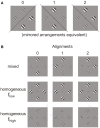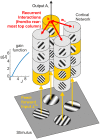Contextual Interactions in Grating Plaid Configurations Are Explained by Natural Image Statistics and Neural Modeling
- PMID: 27757076
- PMCID: PMC5048088
- DOI: 10.3389/fnsys.2016.00078
Contextual Interactions in Grating Plaid Configurations Are Explained by Natural Image Statistics and Neural Modeling
Abstract
Processing natural scenes requires the visual system to integrate local features into global object descriptions. To achieve coherent representations, the human brain uses statistical dependencies to guide weighting of local feature conjunctions. Pairwise interactions among feature detectors in early visual areas may form the early substrate of these local feature bindings. To investigate local interaction structures in visual cortex, we combined psychophysical experiments with computational modeling and natural scene analysis. We first measured contrast thresholds for 2 × 2 grating patch arrangements (plaids), which differed in spatial frequency composition (low, high, or mixed), number of grating patch co-alignments (0, 1, or 2), and inter-patch distances (1° and 2° of visual angle). Contrast thresholds for the different configurations were compared to the prediction of probability summation (PS) among detector families tuned to the four retinal positions. For 1° distance the thresholds for all configurations were larger than predicted by PS, indicating inhibitory interactions. For 2° distance, thresholds were significantly lower compared to PS when the plaids were homogeneous in spatial frequency and orientation, but not when spatial frequencies were mixed or there was at least one misalignment. Next, we constructed a neural population model with horizontal laminar structure, which reproduced the detection thresholds after adaptation of connection weights. Consistent with prior work, contextual interactions were medium-range inhibition and long-range, orientation-specific excitation. However, inclusion of orientation-specific, inhibitory interactions between populations with different spatial frequency preferences were crucial for explaining detection thresholds. Finally, for all plaid configurations we computed their likelihood of occurrence in natural images. The likelihoods turned out to be inversely related to the detection thresholds obtained at larger inter-patch distances. However, likelihoods were almost independent of inter-patch distance, implying that natural image statistics could not explain the crowding-like results at short distances. This failure of natural image statistics to resolve the patch distance modulation of plaid visibility remains a challenge to the approach.
Keywords: contextual interactions; feature integration; natural image statistics; network model; visual cortex; visual perception.
Figures









Similar articles
-
Barber-pole illusions and plaids: the influence of aperture shape on motion perception.Perception. 1993;22(10):1155-74. doi: 10.1068/p221155. Perception. 1993. PMID: 8047406
-
Phase-reversal discrimination in one and two dimensions: performance is limited by spatial repetition, not spatial frequency content.Vision Res. 1995 Aug;35(15):2157-67. doi: 10.1016/0042-6989(94)00296-7. Vision Res. 1995. PMID: 7667928
-
Local masking in natural images: a database and analysis.J Vis. 2014 Jul 29;14(8):22. doi: 10.1167/14.8.22. J Vis. 2014. PMID: 25074900
-
Visual recognition based on temporal cortex cells: viewer-centred processing of pattern configuration.Z Naturforsch C J Biosci. 1998 Jul-Aug;53(7-8):518-41. doi: 10.1515/znc-1998-7-807. Z Naturforsch C J Biosci. 1998. PMID: 9755511 Review.
-
Efficient processing of natural scenes in visual cortex.Front Cell Neurosci. 2022 Dec 5;16:1006703. doi: 10.3389/fncel.2022.1006703. eCollection 2022. Front Cell Neurosci. 2022. PMID: 36545653 Free PMC article. Review.
Cited by
-
Constrained inference in sparse coding reproduces contextual effects and predicts laminar neural dynamics.PLoS Comput Biol. 2019 Oct 3;15(10):e1007370. doi: 10.1371/journal.pcbi.1007370. eCollection 2019 Oct. PLoS Comput Biol. 2019. PMID: 31581240 Free PMC article.
References
LinkOut - more resources
Full Text Sources
Other Literature Sources

